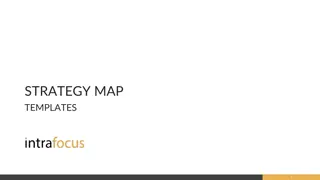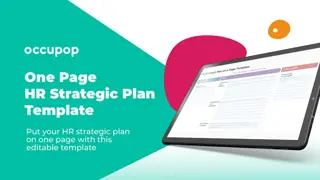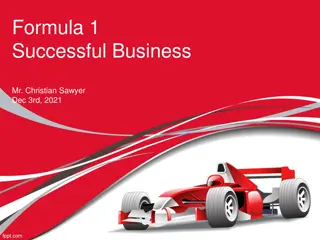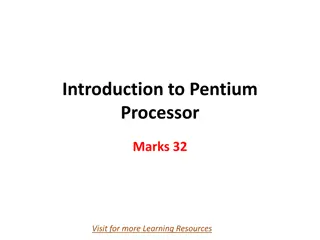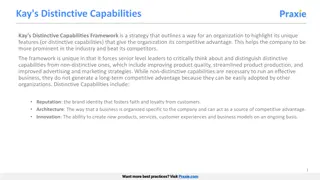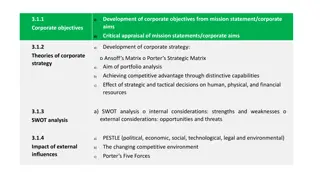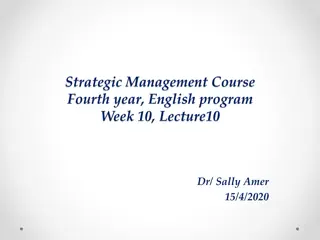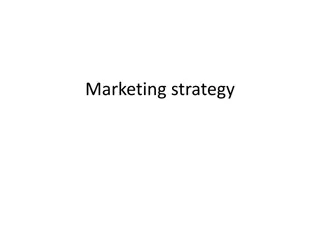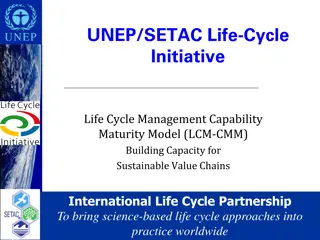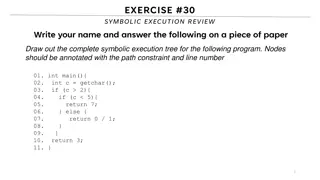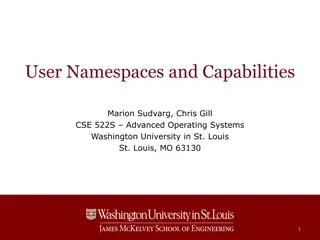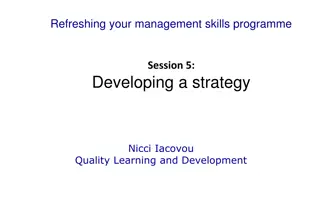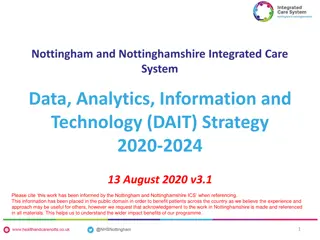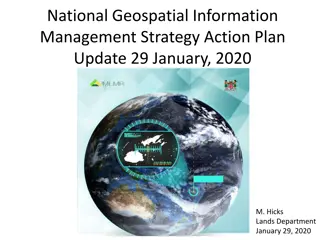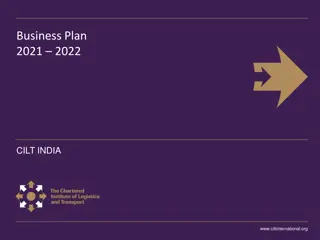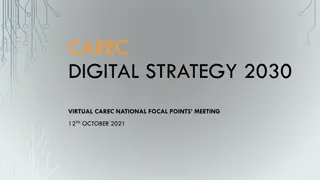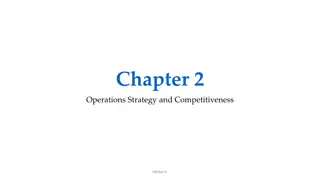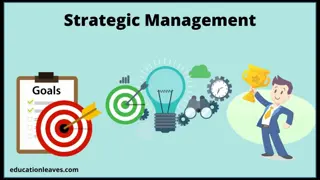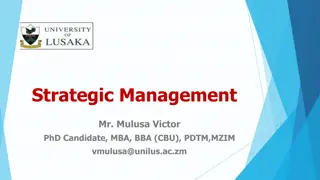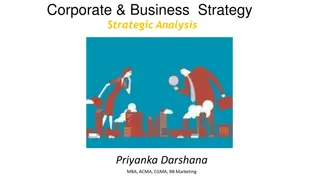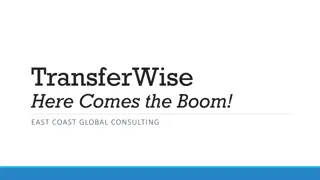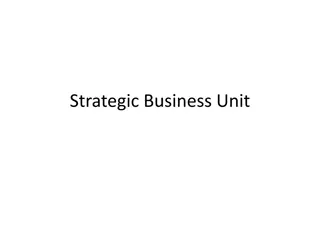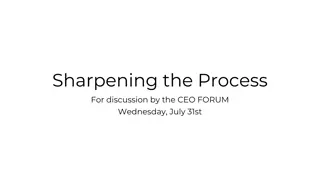Developing Strategic Capabilities: A Guide to Aligning Strategy with Execution
Explore the importance of aligning capability-building activities with strategic intent in companies. Learn the three-step process of creating a blueprint, building, refining, and scaling distinctive capabilities to ensure strategic success. Utilize templates to design a capabilities system that enhances your organization's value proposition.
Download Presentation

Please find below an Image/Link to download the presentation.
The content on the website is provided AS IS for your information and personal use only. It may not be sold, licensed, or shared on other websites without obtaining consent from the author. Download presentation by click this link. If you encounter any issues during the download, it is possible that the publisher has removed the file from their server.
E N D
Presentation Transcript
Introduction About peeling the onion In many companies, capability-building activities are not aligned with the enterprise s strategic intent. This lack of connection between strategy and execution stems in part from the ingrained habit of not taking strategic issues into account when planning new implementations. Companies that make their strategy work, however, translate the strategic into the everyday. They build and connect the cross-functional capabilities that deliver their strategic intent. In order to build these capabilities, many of them go through a three-step process: they create a blueprint that defines their most distinctive capabilities; they build and refine them; and then bring them to scale across their enterprise. The first step is an intensive, deductive analysis of the capabilities needed to make their value proposition work. We call this process peeling the onion. It results in a detailed design of the capabilities system that explains how and why it will deliver the promised value. The following pages contain templates that lead users through the key questions they need to answer to ensure that the capabilities system they design will enable their strategy. In the second half of the document, we have included an example of what those templates could look like when filled in the content, of course, if highly specific to a given company. create a blueprint defining the most distinctive capabilities build and refine capabilities bring capabilities to scale across their enterprise Note: A capability is the combination of people, organizations, processes, systems, tools and knowledge focused on delivering an outcome. A capabilities system is the combination of three to six mutually reinforcing capabilities that distinguish a company and together allow it to create value in its chosen market. 1
Introduction How to use these templates On the following pages are blank templates that can guide you through the process of determining the best design for a capabilities system that will enable your strategy. 1) Inputs and outputs of each distinctive capability and how the system enables the way to play 2) For each capability: a) What is it? b) Why is it valuable? c) How is it different from today? 3) For each capability, what does it look like in action? 4) For each capability, what is required to make it happen? 5) For the capabilities system, what does the business case look like? For best results, please fill them out in sequence and make sure the content in each template builds on decisions you have made on previous ones this ensures that your capabilities will enable your value proposition. Have people in charge of building a given capability fill in the respective templates, then review and iterate all capability designs together to make sure the system as a whole works for your company. 2
Peeling the onion template Example: templates filled in 3
1. How the capabilities system enables the way to play How the capabilities system enables the way to play <Please describe how the capabilities system enables the way to play; see example on page 13> <Your <Your capability 1> capability 2> <Your <Your capability 4> capability 3> 4
Fill out one such template for each capability in your system 1. <Capability 1> inputs and outputs Outputs <Please list key outputs; see example on page 14> <Capability 1> 1. Inputs and outputs Inputs <Please list key inputs; see example on page 14> 5
Fill out one such template for each capability in your system 2a. <Capability 1> what is it? <Please describe your capability; see example on page 15> <Capability 1> 2. What is it? 6
Fill out one such template for each capability in your system 2b. <Capability 1> why is it valuable? <Please describe why this capability is valuable, what impact it has; see example on page 16> <Capability 1> 2. Why is it valuable? 7
Fill out one such template for each capability in your system 2c. <Capability 1> how is it different from today? <Please state what is not working today that you would like to fix; see example on page 17> <Capability 1> 2. How is it different from today? 8
Fill out one such template for each capability in your system 3. <Capability 1> what does it look like in action? <Please describe what your capability looks like in action, how it works; see example on page 18> <Capability 1> 3. What does it look like in action? 9
Fill out one such template for each capability in your system 4. <Capability 1> what is required to make it happen? Processes Knowledge, skills and behaviors <please list required processes; see example on page 19> <please list required knowledge, skills and behaviors; see example on page 19> <Capability 1> 4. What is required? Tools and systems Organization <please list required tools and systems; see example on page 19> <please list required organizational components; see example on page 19> 10
5. What does the business case look like for the capabilities system? The benefits The costs One-time benefits One-time costs Recurring benefits Recurring costs Benefits Costs Year 1 Year 2 Year 3 Year 4 Year 5 11
Peeling the onion templates Example: templates filled in 12
1. How the capabilities system enables the way to play How the capabilities system enables the way to play Being able not just to develop, but to sell solutions is a key feature of any successful solutions provider Solution selling <Your capability 2> <additional bullets about capabilities 2, 3 and 4> <Your <Your capability 4> capability 3> 13
Fill out one such template for each capability in your system 1. Solution selling inputs and outputs Outputs Long-term strategic relationships Profitable solutions with value pricing Solution selling 1. Inputs and outputs Inputs Previous designs Pricing schemes Supplier bench 14
2a. Solution selling what is it? Build long-term strategic relationships Sell as early as possible into the customer s development cycle Sell solutions, not products Sell to strategic buyers, not to purchasing Select own tier-2 suppliers Design to concept Control product definition and rapidly resolve design uncertainties Select technologies to be used Manage solution value proposition Use previous designs Develop financial profile of solution prior to being awarded the contract Manage program and customer to minimize number of design studies and design changes Maximize control of performance qualification Conduct tests Set and control solution performance levels Solution selling 2. What is it? 15
2b. Solution selling why is it valuable? Minimize risk for downward / commodity price spiral Maximize ability to influence or control specifications and targets Transform price-based sale to value-based sale Eliminate high-cost transactions and conflicts of forced partnerships Protect technology from competitors Reduce/eliminate investment in evaluation of design alternatives Solution selling 2. Why is it valuable? Reduce number and extent of changes over the development life-cycle Select profitable programs Manage program life-cycle economics from the beginning 16
2c. Solution selling how is it different from today? We are brought into platform development at too late a stage to influence the value proposition of solutions Limiting design flexibility Constraining opportunities to sell expertise Focusing attention on price We achieve high levels of customer satisfaction primarily by acceding to every customer demand Solution selling 2. How is it different from today? Facing high costs, driven up mainly by customers design changes that whipsaw own product development Unstable product definition Changes under the covers that are irrelevant for end customer Customers often specify suppliers that generate incremental costs for both them and us Requiring changes Creating supply problems Delivering components with quality problems Customers require us to share technology or design responsibility, diminishing a source of advantage 17
3. Solution selling what does it look like in action? Participate in development team early, when overall concept is being worked out Participate in development of concepts and environment Jointly set targets for solutions and performance specifications Act as black box tier-1 supplier based on own strategic relationships Select own suppliers and manage them through strategic sourcing relationships Manage own technology and know-how transfer with suppliers Solution selling 3. What does it look like in action? Develop initial designs based on previous designs and own engineering capabilities Develop features of solutions based on end-market understanding Configure standard subsystems Negotiate changes made by customers and manage their impact on development schedule and cost Negotiate non-value-added changes away Batch necessary changes and cost them Manage program schedule to customer s and own milestones and deliverables 18
4. Solution selling what is required to make it happen? Processes Knowledge, skills and behaviors Long-term strategic relationship mgmt with customers Strategic sourcing relationship mgmt with suppliers Relationship mgmt with customers development teams Development of product targets Development and mgmt of product specifications Program/project mgmt Engineering change mgmt Evaluation of design performance (quality tracking) Warranty and product liability mgmt Structuring mutually beneficial relationships with customers Balancing customers desire for exclusivity with own need to leverage scale in design Sourcing strategically Making performance trade-offs Calculating performance specification tolerances Processing and managing warranty claims Managing responsibilities associated with product liability (due diligence, legal precedents, financial reserves) Solution selling 4. What is required Tools and systems Organization Detailed program mgmt schedule and performance tracking system Detailed program budget and cost tracking system Performance-based system for project mgmt Project development and manufacturing financial models Past design performance database Engineering change and release system Strategic sourcing supplier database Inventory of previous solutions Upgrading of key account managers Increased roles and responsibilities Linking of incentives to account profitability Strengthening of support functions Legal/IP Financial modeling Quality management Hiring of product data managers 19
5. What does the business case look like for the capabilities system? The benefits The costs One-time benefits One-time costs IT systems development (5, 10, 1, 0, 0m) Recruiting cost (3, 2, 0, 0, 0m) Recurring benefits Avoidance of design changes (3, 5, 10, 10, 10m) Value-based pricing (2, 4, 6, 6, 6m) New customers (0, 0, 5, 8, 12m) Recurring costs 15 FTE product managers (0.8, 1.5, 1.5, 1.5, 1.5m) 25 FTE Engineers (2.5, 4, 4, 4, 4m) IT upgrades (0.0, 0.0, 0.3, 1, 1m) Benefits Costs Year 1 Year 2 Year 3 Year 4 Year 5 Note: Parentheses state contributions or costs in each of the first five years, in million USD 20


